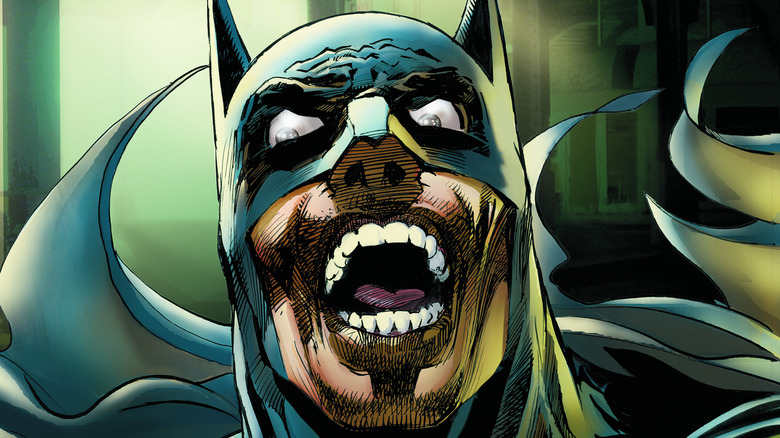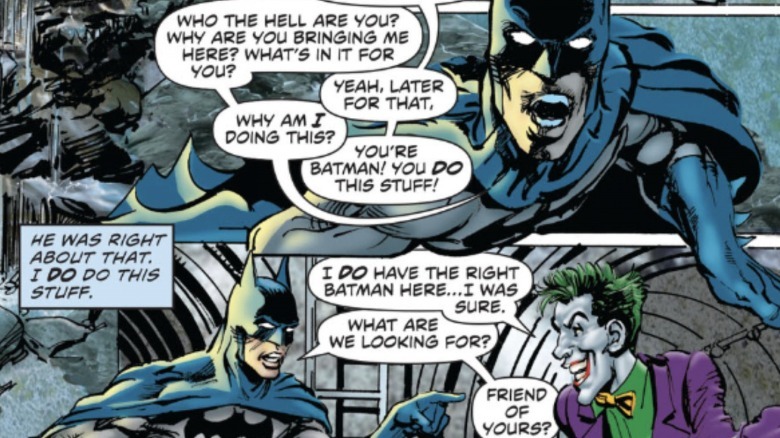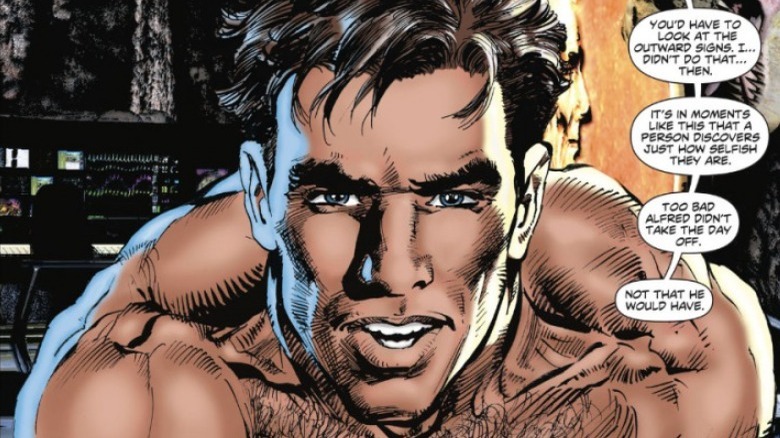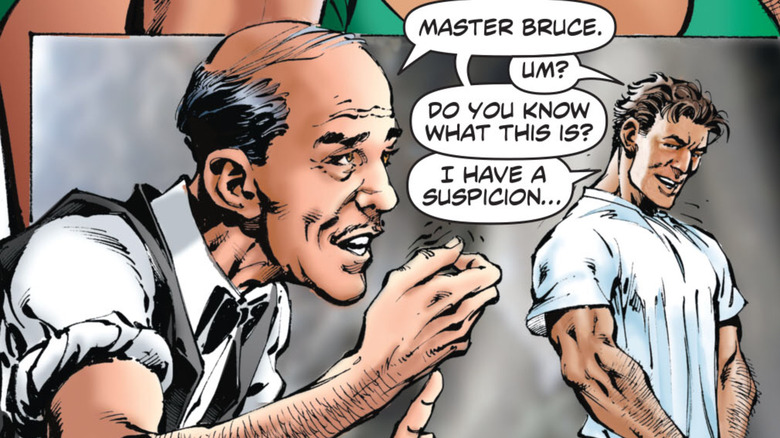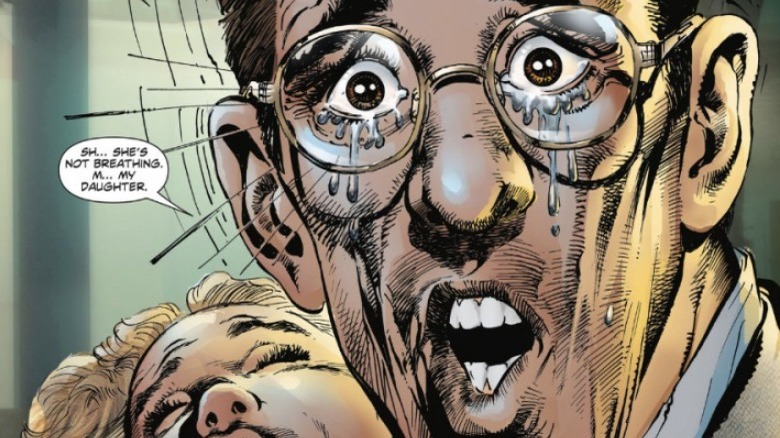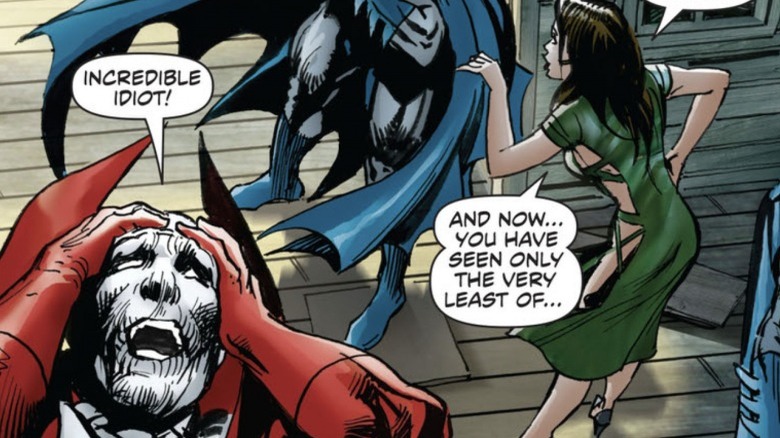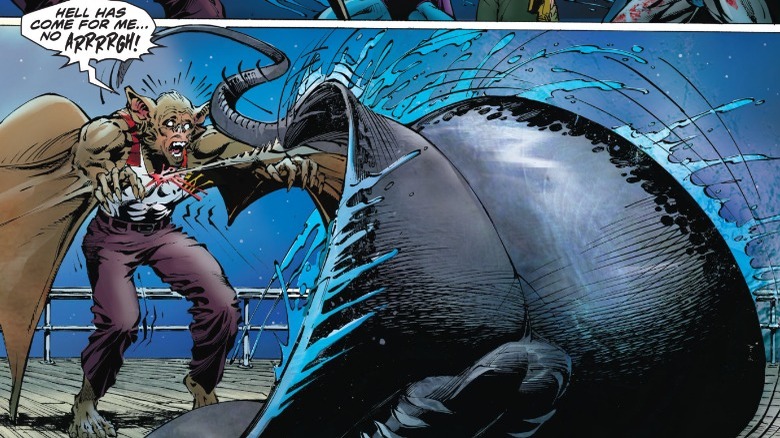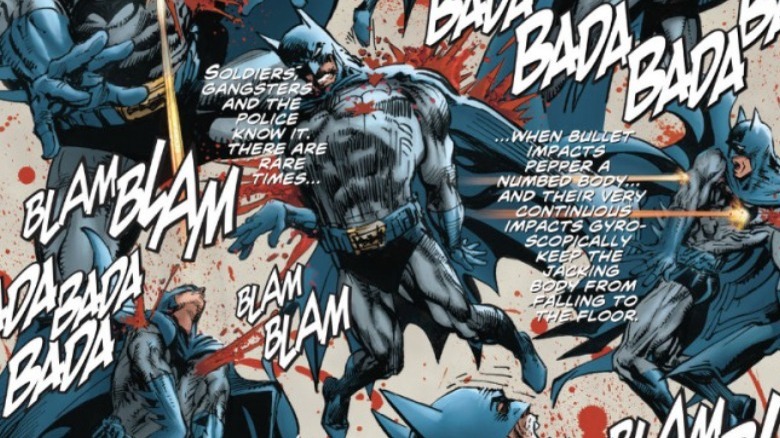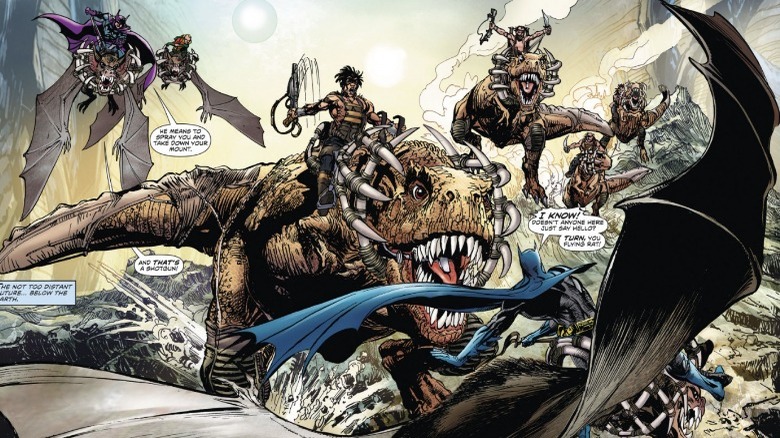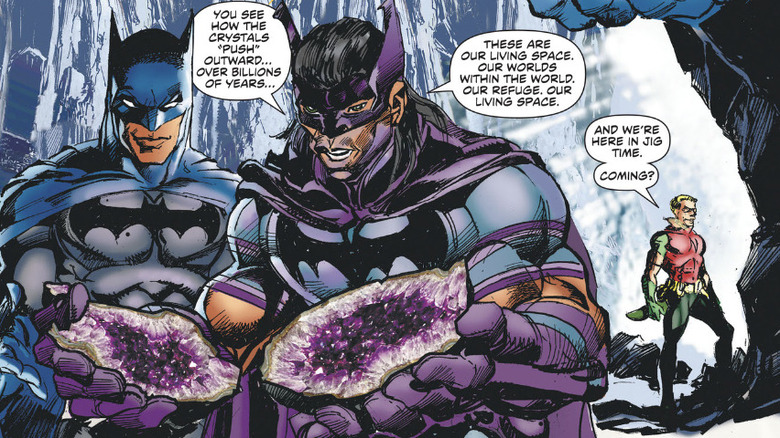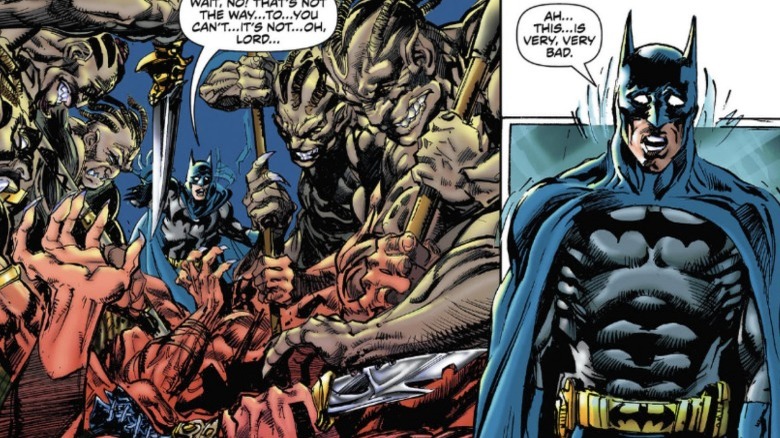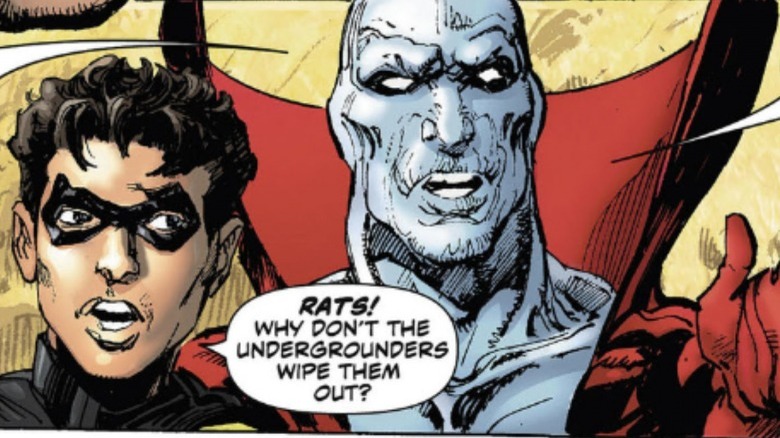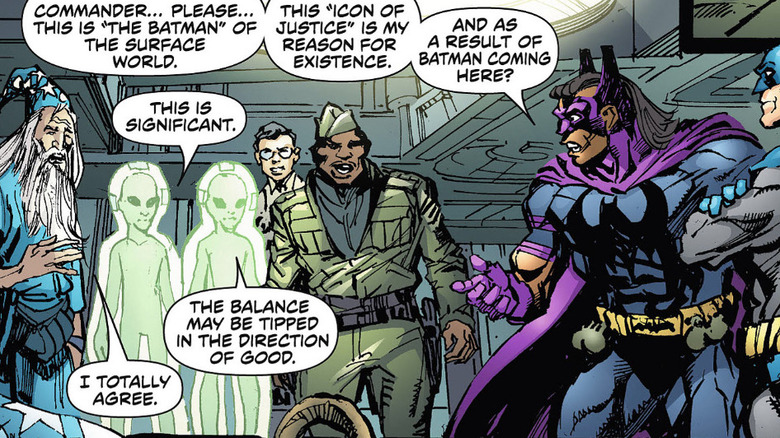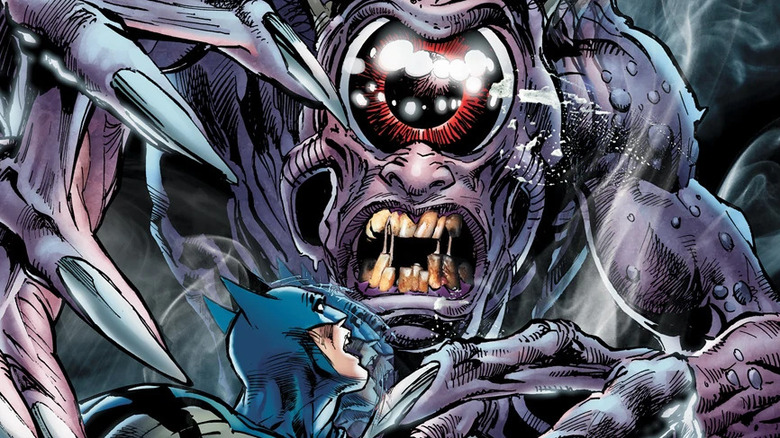The Bizarre Story Of Batman: Odyssey
Few artists in comics have cast as long a shadow as Neal Adams. Almost everything we think of as the dividing line between "classic" and "modern" comics — the realistic artwork, the shadowy, gritty settings, the subtler colors — originated with him. He's drawn nearly every character in both the DC and Marvel Universes, but even if he never did anything else, his stature would be secure for his work on Batman.
Adams redefined the do-gooder who had dominated most of the characters' early TV and comic-book interpretations into the dark and haunted hero we know and love today. With writer Denny O'Neill, he turned the Joker from a harmless prankster to a genuine threat, having him commit his first murder in decades. Adams also introduced enduring new villains, like Ra's al Ghul and, with writer Frank Robbins, Man-Bat.
So you'd think if anyone had earned a blank check for a "Batman" book, it would be Adams. However, if DC expected another masterpiece, they got something altogether different. Over on Comics Alliance, Laura Hudson and David Wolkin devoted a six-part series to "Deconstructing the Complete and Utter Insanity of 'Batman: Odyssey," and they still left more than plenty for us to unpack. Buckle up.
Neal Adams is a unique writer
As a writer, Neal Adams is a good artist. When you look at "Batman: Odyssey" that way, it almost begins to make sense. What if Adams thought of a bunch of cool stuff to draw and then failed to connect it all into a narrative?
"Batman: Odyssey" has more intersecting timelines than "Pulp Fiction," with no indication of which one we're in any moment, and half of them are Batman telling an unseen listener a story about a story he told Robin, which contains other stories inside that.
Every first draft seems to have gone straight to print. One character's name might be Blades or Irons, depending on what page you're reading. Beyond that, the characters refer to a tribe of underground dwellers as trolls and gnomes interchangeably — which gets even more confusing when a totally separate tribe of gnomes shows up. As Hudson and Wolkin point out, the first- and third-person narrators seem to be arguing with each other: "This is unusual for Batman." "This isn't unusual ... for me."
On a sentence-to-sentence to level, the writing's even more bizarre. Here are a few standouts, and rest assured, only some of them make any more sense in context: "For television? Yes. Yes." "Watch yer drivin', ya foul-breathed kite-lizard." "Sworn to secrecy! Such a thing! Such an octopus of a thing!" and "Aquict yourself, you kung fu movie guru," from Killer Croc, who has apparently bought a word-a-day calendar. A subterranean gnome uses Stephen Colbert's catchphrase, "truthiness."
"I'm sorry ... for the lameness of my words," Batman narrates in the penultimate issue. Too little, too late, Bats.
Batman spends every issue seducing the reader
The first thing you'll notice about "Batman: Odyssey" is that every issue begins with an apparently nude Bruce Wayne sitting uncomfortably close to you. Sure, you could say we're reading too much into what Hudson and Wolkin affectionately call "Nude Bruce," but he certainly seems to be working on his seduction technique.
In Part 5, he lovingly unpeels a banana in front of us before Alfred gingerly picks it up like he's about to drop it in somebody's path in an old-time slapstick comedy. Part 6 opens with Batman reaching through the panel borders to shove a pickax in our face, which immediately makes Hudson and Wolkin concerned they're watching a torture scene and inspires them to dub the reader's stand-in as the "Exposition Hostage." But we can't help but wonder if Bruce has more intimate plans for that pickaxe.
On one disturbing page, he moves closer and closer until he's finally literally in your face. Eventually, in Part 7, Bruce stands up to reveal he's wearing shorts. Later, in Part 8, he covers his carpet of chest hair with a Green Lantern T-shirt. Why does every issue start this way? You may as well ask why anything in this comic happens the way it does, and you'll get no answers there either.
Batman: Odyssey is accidentally filthy
The Nude Bruce scenes alone may have inspired some comic shop owners to hide "Batman: Odyssey" in the adults-only section. However, quite a few other sequences make the series even filthier than most of the books you'd find there — all seemingly obliviously.
First, Alfred makes the universal hand gesture for sex while asking Bruce, "Do you know what this is?" Bruce responds, "I have a suspicion." Us dirty-minded readers' suspicions, on the other hand, turn out to be wrong since Alfred explains he's playing the world's smallest violin. We may have to question if Alfred's really the man of culture he claims to be if he thinks that's how you play the violin.
In Part 6, Sensei is testing his mettle on a safe. Over four increasingly sweaty panels, the Sensei describes how "The blood flows outward and back again. ... Binding ... Dis-weighting ... lubricating ... feel... Apply pressure, up, then down. And down again. Now. Umphh. Ahh. Slowly ... slowly ..."
Then, in Part 10, Robin rides a pterodactyl — as you do. When he finally gets his reins on it, he says, in a line that's inexplicable in more ways than one, "This is a lead-pipe cinch. I feel like I'm riding my old egg-cream buddy Man-Bat." Beyond the obvious questions of just what a teenager is doing using musty old phrases like "lead-pipe cinch" and "egg-cream," it also raises some very serious questions about just what kind of "riding" Robin and Man-Bat were doing.
Batman almost beats a guy to death for killing a little girl without making sure she's actually dead
When Digital Spy asked Adams, "Can you give us an overview of the plot?" he simply responded, "I cannot give you an overview of the plot." At the time, it seemed like spoiler protection, but now it seems just as likely he literally couldn't explain it. It takes nearly half the series for the conflict between Ra's al Ghul and Sensei for the world beneath the world to take form, and everything that happens in the series' first volume is just one inexplicable and incomprehensible event after another,
However, no plot takes so long to contribute so little as Batman's trip to the docks in Parts 1 through 3. He ignores a major plot by the Riddler to prevent the theft of some fake dinosaurs and a hydrogen-powered car and never explains why — but does explain why shooting the car won't make it explode over and over again.
The car's inventor and his daughter are there too, and when Reuben Blades/Irons shoots at Batman, the little girl gets caught in the crossfire. Even though we see immediately that it only grazed her, Batman skips straight past diagnosis and first aid and onto vengeance, as represented on the cover by him screaming at a wig. Adams shows us in graphic detail as Batman beats Blades/Irons nearly to death until we get the resolution telegraphed from the beginning that the girl's okay. We also get to see a full-page splash of the father's hilariously exaggerated crying face, and then Adams traces it again for an encore.
Classic DC characters appear out of nowhere
The series of seemingly random events presented in "Batman: Odyssey" become even stranger when the rest of the DC Universe gets involved. In Part 1, Batman and Robin continue their discussion on gun ethics while Man-Bat flies Robin around the room, delivers a cryptic message, and disappears.
In Part 4, Batman is on a boat fighting Ra's al Ghul's bodyguard Ubu, when suddenly a stingray appears on deck and takes Ubu out of commission (don't worry, we'll get into that). When Batman demands, "Who. Did. This?" continuing after an interruption from Talia, "Shut up! Who?" Aquaman casually saunters up to take credit. Batman dives overboard. Aquaman follows and tells Batman to stay out of his territory by summoning a whale, which somehow sneaks up on the World's Greatest Detective so badly it startles him into thinking, "A whale? A whale? A whale?!!!" And then Aquaman's never seen again.
Deadman has a larger role, no doubt, because Adams' run on the character was one of his biggest early hits. However, he shows up without any more explanation than Aquaman and spends most of his time in Part 1 without interacting with the plot except to kvetch about Batman. Deadman's ghostly powers mean he needs to inhabit someone else's body every time he does interact with the story, except when they're underground, for some reason, meaning we get a couple of issues of Batman running around with the Joker.
Neal Adams has some strange ideas about zoology
Adams' blank check on "Batman: Odyssey" apparently extended to no one correcting his ignorance of basic animal facts. In this book's world, stingrays can fly and shoot harpoons out of their butts. The first time the stingray shows up in Part 3, you could try to justify its aerial abilities as simply flopping up on the deck of a ship the way fish sometimes do. But there's not much ambiguity when it reappears in the next issue, shooting straight out of the water as cleanly as a helicopter.
Then there are the bizarre creatures Sensei unleashes to eat straight through an Arkham cell door. He calls them "winged worms," but they look a lot more like bees as drawn by someone who'd never seen a bee before — except perhaps in Dr. Seuss books, with huge, stripey stingers on the wrong end. "It's unscientific," says one of the Arkham inmates. You got that right, pal.
The bee/worms' appearance seems especially significant after Batman's reaction to discovering the invading Amazon's weapon of mass destruction was killer bees went viral three years before the publication of "Batman: Odyssey." It's not the only thing in the series that would make more sense as a prank.
Batman: Odyssey works by playground rules
The best comics tap into the seemingly endless reserves of our childhood imaginations, such as "flying" from the jungle gym to the swingset to the slide with a blanket as a cape. The worst never progress beyond simple kid logic with their endless goalpost-moving. "I shot you with my laser!" "Nuh-uh, I'm wearing my laser-proof vest." "Nuh-uh, I have an armor-piercing laser." "Nuh-uh," and so on. Guess which one "Batman: Odyssey" has more of?
First, when Batman discovers a bomb on a train in Part 1, he has to open the detonator to make sure the button can't be "un-pressed." Then in Part 2, we see Batman get shot. A lot. All through a hilarious full-page montage as his body's whipped back and forth, blood flying everywhere. But he's fine, of course. He's Batman. When you're Batman, you can reveal you have a completely invisible bulletproof shield you've never used before just because you've been written into a corner.
By Part 6, he discovers that Dr. Slattern has built himself a futuristic suit out of all the confiscated weapons at Arkham and now insists on being called Trigger. Trigger thinks he has Batman on the ropes when he shoots him full of darts from a giant stun gun. Batman hardly seems to notice, only saying, "Massive charge. Suppose I reverse that charge." And then he does, sending all the electricity back to Trigger. How? No explanation is given, which, as Hudson and Dworkin observe, might as well be the motto of the whole series.
Batman gets to ride dinosaurs and giant bats
"Batman: Odyssey" Part 6 ends with not just one of the series' strangest moments but one of the most bizarre endings to any comic ever written. When Ra's al Ghul arrives in the Batcave to send Batman on a mission against Sensei with the fate of the world in the balance, Batman responds by collapsing on the floor and taking a nap while Deadman continues to invisibly cuss him out.
For eight months, that was it. Was "Odyssey" lost forever in the shuffle of DC's "New 52" relaunch? Did Adams intend to end his epic with naptime? No, he just wanted to bring it back even more buck wild than ever. "Batman: Odyssey" Vol. 2, #1 takes us to "the not too distant future ... below the earth," and there Batman is, riding on a giant bat and fighting machine-gun-toting mercenaries on Tyrannosaurus. Say what you want about this series, it was all worth it for this one image.
The Batman and Robin lookalikes who had been hanging around in the background for most of the series with, of course, no explanation, are actually subterraneans inspired by TV broadcasts of the originals. Here we meet the neanderthal Jamroth Bok and the evolved dinosaur Primus, whose disturbingly wide mouth always makes it look like he's about to unhinge his jaw and swallow a cow whole. And then it gets weirder.
Batman: Odyssey is an excuse for Neal Adams to push his pet theories
To you or me, Batman's underground adventures might all seem like classic comic book silliness. But to Neal Adams, it's a profound revelation that proves everything we know is wrong. For decades, he's been beating the drum for his "expanding earth" theory, one he insists the scientific establishment is hiding from you, as opposed to the more likely possibility they dismissed it as pointless nonsense.
Adams, of course, is an artist, not a scientist, and his explanation of Wired's description of his revelation inspired by the Pangaea theory makes that abundantly clear: "Put yourself in my place. You listen to this and as an artist you try to visualize it. And it occurs to you that this is totally wrong." Wired paraphrased Adams' theory as such: "The whole arrangement — with the übercontinent Pangaea on one side of the globe and empty ocean on the other — looked lopsided."
That was the dubious beginning of a lifelong obsession that he believes disproved plate tectonics, relativity, and nearly every pillar of science you could name. Faced with the law of conservation of matter, he simply invented "prime matter." And if you think that sounds grandiose, listen to this: "I want to see antigravity. I want to see intergalactic communication. If I'm right, those things will happen."
We doubt Adams actually believes the expanding earth is full of cavemen and dinosaurs, but he still gives Bok and Primus a few pages in Part 7 to lecture all of us just in case he wins some comic-book-reading converts.
Batman accidentally incites a mob killing
If there's one thing Batman cares about, it's justice, preferably shouted at the top of his voice. However, he learns the hard way he can't just introduce his idea of justice to a foreign culture when Primus takes him back to his village of dinosaur people. Batman uncovers the two traitors who sold the villagers' Tyrannosaurs to Sensei's mercenaries based on their suspicious influx of money and surface goods (including — oof — buying wives). He gives a rousing speech about justice and how evildoers need to be caged to protect the rest of the community.
Then he turns around to see the rest of the dinosaur people ignore the advice of their guest (who they inexplicably call "father") about caging the criminals. But they're extremely enthusiastic about the "punishing evildoers" part and gorily slaughter the traitors. His reaction is, "Wait, no! That's not the way ... to ... you can't ... it's not ... oh, Lord. Ah ... This ... is very, very bad. ... I knew this wasn't going to be a good day," which seems like a bit of an understatement. In the world of "Batman: Odyssey," inciting a mob to brutal murder apparently doesn't rate more than a sad trombone.
Batman: Odyssey gets pretty darned problematic
Adams has been making comics for a long time, and it's frequently said that we need to deal with older people's prejudices with the knowledge they were raised in another time. Unfortunately, that doesn't quite explain a lot of what goes in "Batman: Odyssey," which might have turned heads in his grandfather's time. There are an awful lot of Asian villains who could have stepped right out of the pages of "Fu Manchu" and not too many other Asian characters other than the ever-ambivalent Talia.
Speaking of Talia, Batman and Bok's quest to retrieve her and Bok's wife Tatsinda isn't necessarily sexist, but the sheer amount of times they refer to them as "our women" makes it hard to call it anything else.
Then there are the trolls. Oh, the trolls. Hudson and Wolkin give a lengthy list of the racial stereotypes the loc-wearing, dark-skinned creatures embody: They accept worthless trinkets as valuable currency. They're cannibals, but they'll bow and flatter if you beat some sense into them. Robin, Champion of Justice, openly advocates for their genocide. To that, we can add that their wide mouths, sharp teeth, and bug eyes look uncomfortably like old-time racist caricatures.
Just so no one feels left out, there's El Maniaco from Part One, back when "Odyssey" was a book about Batman investigating a robbery and flashing back to his first adventure. He's a Mexican, well, maniac, who wears an indigenous-style headband, hasn't shaved or cut his hair in months and is drawn with a set of yellow teeth the size of bowling balls.
Just when you think Odyssey can't pack in any more weird ideas, it drops in ten at once
Once the second volume of "Odyssey" begins, you might think you know where you're at. It's a deeply weird place to be at, but still, there's a single plot and setting instead of the sixty million we've had up until now: Batman needs to rescue the women, keep Sensei from taking over the Hollow Earth, and that's about it. But Adams is never going to let us relax that long.
In a single page in Part 10, whatever we sense we might have had of where this story is headed goes out the window. There, Adams introduces space aliens, genetic experiments based on and/or inspiring the Egyptian gods, World War 1 doughboys, the Library of Alexandria, an underground TV studio, immortal scientists, and jazz magicians.
Yes, jazz magicians, and we can call them that because Batman does. These magical musicians talk in sentences like, "It's gonna seem uncool for you ... even so, this is a righteous beef." How does Batman identify these jazz magicians? Because he recognizes one as a clarinet player from a glance at his lips, which seems like a stretch — even for the World's Greatest Detective.
Batman: Odyssey ends by fracturing the narrative beyond all repair
So, how do you wrap all this up? The same way you start it: with total incomprehensibility. In Part 10, Deadman beats the snot out of the gnomes for "the Key to the Nile." We never learn what the key is, just that it's real important.
By Part 12, the "Exposition Hostage" correctly points out that there are a lot of holes in Batman's story. So, first, we get a flashback to some indeterminate point earlier on and learn Batman descended even further into the earth and used the key to unlock a door to — something. Before he can get that far, he has to fight a cyclops. A psychic cyclops, who Batman defeats with the old joke about the "henway." Also, Adams' colorists Moose Baumann and Cory Adams fill in the cyclops' teeth with photos of real, rotten chompers, which doesn't have anything to do with the plot. It's just gross, is all.
Anyway, Batman returns to Arkham for his final showdown with Sensei and resolves the running debate over whether he's capable of killing by shooting the ever-loving living heck out of Sensei, sending guts flying everywhere.
Or not. Whatever was behind that door, it lets Batman reincarnate the Sensei as a baby to see if he can make a fresh start. Then the "Exposition Hostage" is revealed as Clark Kent, and what started as a Batman comic ends with a big hero shot of Superman. Sure, why not. Makes as much sense as anything else.
